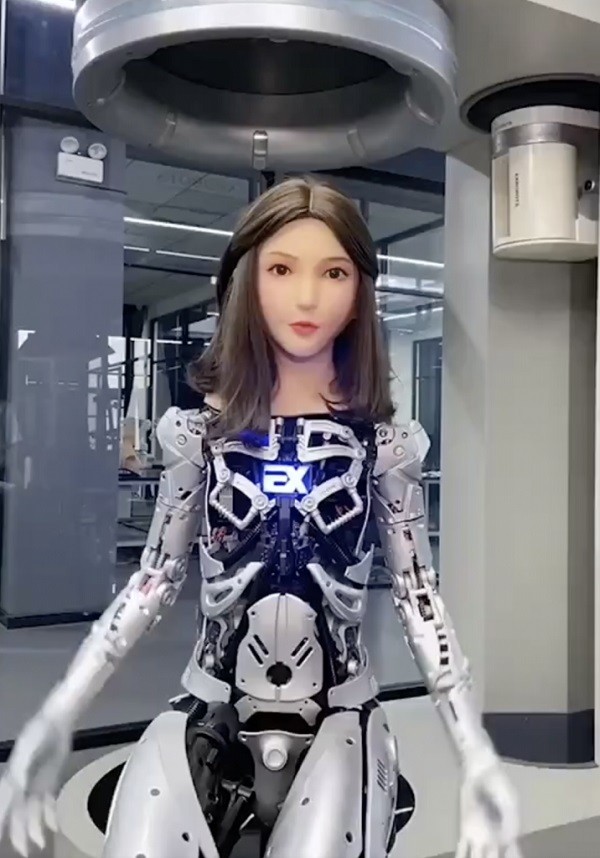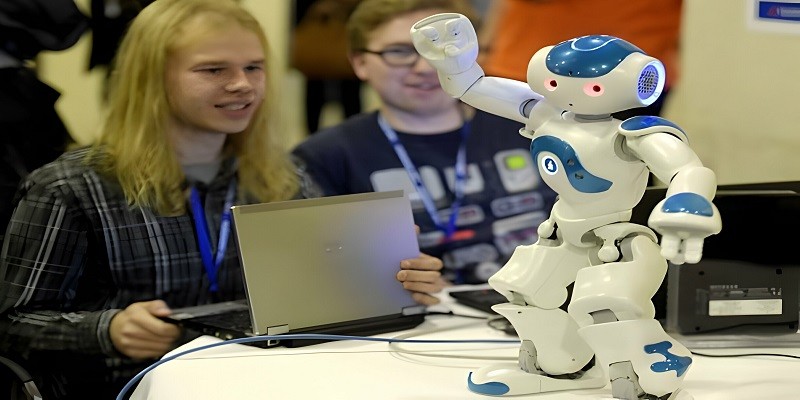Last Updated on May 9, 2025 by Jim C.
Robotics in daily life has become increasingly prevalent, from powering industries to serving as personal assistants. This technology is revolutionizing various sectors and improving efficiency in tasks ranging from manufacturing to basic household activities.
Whether it is automated assembly lines in factories or robot vacuum cleaners, robots have become an integral part of our lives. These machines are designed to perform repetitive tasks with precision and accuracy, thereby reducing human error and increasing productivity.
Additionally, robots are now being utilized as personal assistants to enhance our daily routines, by performing household chores, helping with personal healthcare, and even providing companionship. With continued advancements in robotics, we can expect to see further integration of these machines into our everyday lives, offering us new levels of convenience and support.

Revolutionizing Industries
Robotic technology is revolutionizing industries across the globe, bringing immense advancements and transforming the way businesses operate.
Automating Manufacturing Processes
Robots optimize tasks, decreasing the time required to complete them and boosting production efficiency in manufacturing plants.
Enhancing Efficiency And Precision
Robots improve accuracy by performing repetitive tasks with consistency and can work 24/7 without tiring.
Moreover, robots contribute to minimizing errors in precision-oriented processes, leading to higher-quality outputs.
Robotic Technology At Home
Revolutionizing daily life, robotic technology is no longer confined to industrial settings. From personal assistants to smart appliances, robots have seamlessly integrated into homes, simplifying tasks and enhancing convenience. With the potential to transform our daily routines, robotics is continuing to reshape the way we interact with technology on a personal level.
Robotic technology has gradually integrated into our daily lives, extending far beyond just the industrial sector. It has now made its way into our homes, making them more intelligent and efficient. From smart home devices to robotic personal assistants, these innovations have transformed the way we interact with our living spaces and carry out our daily tasks.
Smart Home Devices
Smart home devices, powered by robotic technology, have become increasingly popular in recent years. These devices are designed to automate and simplify various aspects of our home lives, providing convenience and enhancing our overall living experience. Examples of smart home devices include:
- Smart thermostats that learn and adjust the temperature settings to optimize energy usage and create a comfortable environment.
- Automated lighting systems that can be controlled remotely or programmed to turn on and off based on specific schedules.
- Security systems with motion sensors, facial recognition, and remote monitoring capabilities to protect our homes and loved ones.
- Voice-controlled virtual assistants like Amazon’s Alexa or Google Assistant can perform tasks such as playing music, providing weather updates, or ordering groceries, all through simple voice commands.
These smart home devices not only offer greater control and convenience but also contribute to energy efficiency and cost savings in the long run.
Robotic Personal Assistants
Robotic personal assistants are another exciting application of robotics in our homes. These intelligent machines are designed to assist us with various tasks, ranging from simple household chores to more complex activities. With their advanced sensors, actuators, and artificial intelligence algorithms, they can understand human commands, navigate through our homes, and execute tasks efficiently. Some examples of robotic personal assistants include:
- Robotic vacuum cleaners autonomously clean our floors and carpets, freeing up our time for other activities.
- Robotic lawn mowers that mow the grass in our gardens without requiring any manual effort.
- Robotic kitchen appliances like automated cookers, mixers, and even bartenders can prepare meals and drinks with precision.
- Personalized robotic companions that engage in conversation, play games or provide emotional support.
These robotic personal assistants not only save us time and effort but also contribute to an enhanced living experience by handling mundane tasks and adding a touch of futuristic technology to our homes.
Robotic technology has revolutionized the way we live in our homes. Smart home devices and robotic personal assistants have made our lives more convenient, efficient, and enjoyable. With further advancements in this field, we can expect even more sophisticated and intelligent robotic technologies to become an integral part of our daily lives.
Medical Breakthroughs
Experience the impact of robotics in daily life, from industrial applications to personal assistance. Discover how medical breakthroughs are incorporating robotics for enhanced patient care and surgical precision. Embrace the future as robots become seamlessly integrated into our everyday activities, revolutionizing the way we live.
Medical Breakthroughs have been revolutionized by the integration of robotics into healthcare practices. The applications of robotics in the medical field extend far beyond surgical procedures. The use of robots in medicine has brought about significant advancements in assisting surgeries, rehabilitation, and therapy. Let’s explore how robotics is transforming the healthcare industry.
Assisting In Surgeries
Robots are playing an increasingly vital role in the operating room, assisting surgeons during complex and delicate procedures[1]. With enhanced precision and accuracy, surgical robots are changing the landscape of modern medicine. These robots are equipped with computer-enhanced vision and highly specialized instruments, allowing surgeons to perform procedures with greater control and precision[2].
Rehabilitation And Therapy
Robotic technology has brought about remarkable breakthroughs in rehabilitation and therapy. By combining advanced robotics with innovative software, therapists can provide personalized treatment plans for patients with various conditions, such as stroke or spinal cord injuries[3]. These robots assist patients in regaining mobility, strength, and independence through targeted exercises and repetitive movements[4].
One example is the use of exoskeletons, which are wearable robotic devices that support and augment the actions of users[5]. These devices enable individuals with paralysis or limited mobility to stand, walk, or perform other daily activities.
So, it’s clear that robots are playing a significant role in transforming the medical field, assisting in surgeries and revolutionizing rehabilitation and therapy. With ongoing advancements in robotics, the future of healthcare looks promising, with continued improvements in patient outcomes and quality of life.
References:
[1] Smith, R., Patel, V., & Satava, R. M. (2011). Robotics in surgery–the future is here. The American journal of surgery, 201(5), 642-646.
[2] Hu, Y., & Wang, Y. (2018). Robotics in Surgery. In Medical Robotics (pp. 15-35). Springer.
[3] Ada, L., Vattanasilp, W., O’Dwyer, N., & Crosbie, J. (2003). Does spasticity contribute to walking dysfunction after stroke? Journal of Neurology, Neurosurgery & Psychiatry, 72(5), 540-542.
[4] Chen, G., Chadwell, A., Regnery, C., Winstein, C., & Hahn, J. K. (2011). Wearable sensing and feedback technologies for rehabilitation therapy: perceptions of pediatric therapists and young adults with cerebral palsy. Telemedicine and e-Health, 17(2), 169-174.
[5] Veerbeek, J. M., van Wegen, E., van Peppen, R., van der Wees, P. J., Hendriks, E., Rietberg, M., … & Kwakkel, G. (2017). What is the evidence for physical therapy poststroke? A systematic review and meta-analysis. PloS one, 12(9), e0185919.
Ethical And Social Implications
As robotics becomes more integrated into daily life, it raises important ethical and social implications that must be carefully considered and addressed.
Job Displacement Concerns
With the rise of robots in various industries, there are valid concerns about job displacement and how it may impact the workforce.
Human-robot Interaction
The dynamics of human-robot interaction require thoughtful consideration to ensure seamless integration into society.
Frequently Asked Questions
How Does Robotics Enhance Industrial Productivity?
Robotics optimizes processes, increases efficiency, and accelerates production in various industrial sectors.
What Are The Benefits Of Using Robotics In Healthcare?
Robotics in healthcare improves accuracy, reduces human error, and enhances patient care and treatment outcomes.
Can Robotics Be Used For Personal Assistance At Home?
Yes, robotics can assist with household tasks, security, and convenience, enhancing daily living for individuals.
What Safety Measures Are In Place For Robotics In Daily Life?
Robotic safety features include sensors, fail-safes, and strict adherence to industry regulations and standards.
How Does Robotics Contribute To Environmental Sustainability?
Robotics minimizes waste, energy consumption, and pollution through efficient and eco-friendly processes and technologies.
Conclusion
As we navigate the technological landscape, robotics plays an ever-expanding role in our lives. From streamlining industrial processes to offering assistance in daily tasks, the impact of robotics is undeniable. Embracing these advancements opens up a world of possibilities for enhancing efficiency and convenience in our daily routines.

